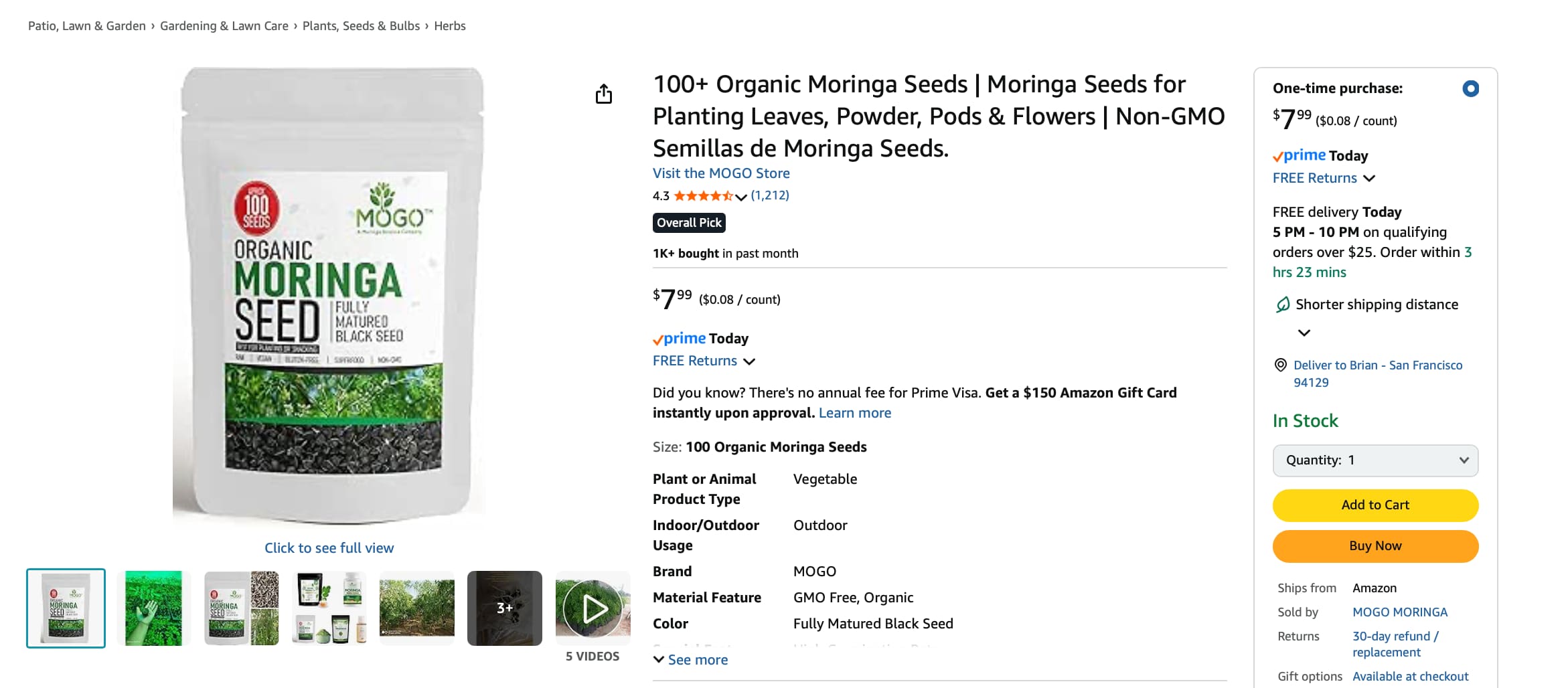I may add an extra dose of SFN before bed, nice article, thanks!
Where and how did you get the seeds? I like this idea. The powdered dry moringa tastes like crap and makes anything you put it in also taste similarly.
I got my seeds from Amazon. It would love the Earth, but I grow it in pots and keep it trimmed down to a fairly small height of about 5 ft. Some practical notes, I find. If I eat it on an empty stomach it’ll give me a tummy ache. I do sometimes snack on it, but more typically in a smoothie with something like strawberry or mango to mask the flavor. I also dry some of the extra leaves to make tea. It was like $8 or something for 100 seeds.
Great - I will try this. 5 Feet high? Wow - how long did it take to grow them to that height? It would seem that this “should” be ok in Northern California, where I am.
See: Amazon.com
Moringa (especially Moringa oleifera, the most widely cultivated species) is a hardy, fast-growing, drought-resistant tree. It grows best in tropical and subtropical climates, but it can tolerate a range of conditions.
Optimal Climate for Moringa
- Temperature: 25–35 °C (77–95 °F) is ideal.
- Rainfall: 250–1,500 mm per year (10–60 inches). It thrives with moderate rainfall but does not tolerate waterlogging.
- Altitude: Best below 600 m (2,000 ft), but can grow up to 1,200 m (4,000 ft).
- Soil: Well-drained sandy or loamy soils; pH 6.3–7.0 preferred, though it tolerates slightly acidic to slightly alkaline soils (pH 5.0–9.0).
- Sunlight: Full sun exposure; it does not do well in shade.
Acceptable Growing Climates
- Arid and semi-arid regions: Moringa tolerates drought exceptionally well once established.
- Subtropical regions: Can grow where winters are mild. Light frost may kill young plants, but mature trees can regrow from roots.
- Humid tropics: Grows well, but excessive humidity + waterlogging can cause root rot.
Not Suitable For
- Cold climates with frequent frost or freezing (below ~5 °C / 41 °F damages growth, frost kills leaves).
- Heavy clay soils or areas with poor drainage.
In summary:
- Optimal: Warm, semi-arid to tropical regions with good sun and well-drained soil.
- Acceptable: Subtropics with mild winters, arid zones if irrigated, humid tropics if soil drains well.
I was enjoying this article. It has some great information about the downstream effects of SFN. " Sulforaphane and Other Nutrigenomic Nrf2 Activators: Can the Clinician’s Expectation Be Matched by the Reality?"
… Sulforaphane is a potent Nrf2 inducer with consequent induction of cellular defenses . The effect is rapid in cell culture with activation by sulforaphane occurring within 30 minutes in human bronchial epithelial BEAS-2B cells. Using microarray analysis to investigate the effect of sulforaphane in the wild-type murine liver, Hu et al. showed that expression levels of 1725 genes were increased after 3-hour exposure and 3396 genes were changed after 12 hours. Comparing expression patterns at different time points, they also showed that maximal change occurred 12 hours after a single administration of sulforaphane, based on fold changes greater than 2-fold.
… Nrf2 target genes include those coding for β -defensin-2 (HBD-2), an antimicrobial peptide associated with innate immunity, protecting the intestinal mucosa against bacterial invasion. HBD-2 can be induced by sulforaphane and was shown in a cell culture study using human Caco-2 cells to be significantly induced 1.6-fold at 24 hours and 2-fold at 48 hours…
